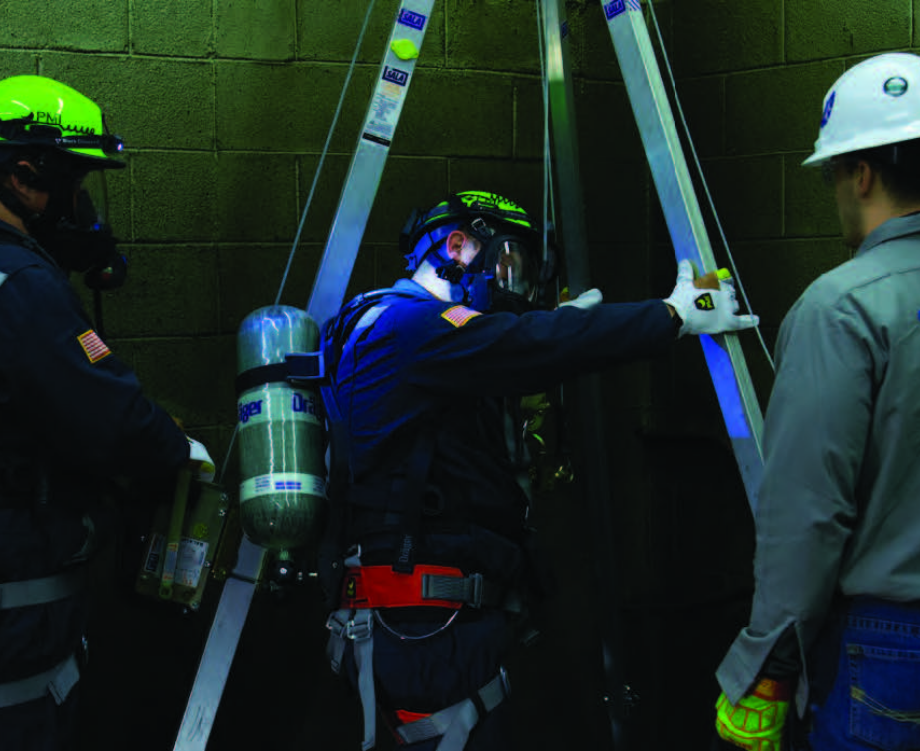Understanding Confined Space Rescue

Working in confined spaces is an inherent part of the construction industry. These areas—characterized by limited entry and exit, poor ventilation, and potential exposure to hazardous conditions—pose significant risks. A confined space can be anything from a storage tank to a utility vault.
In this blog, we cover the dangers associated with confined spaces, including oxygen deficiency, toxic gasses, and physical barriers that can trap or crush workers. Additionally, we delve into proper rescue protocols so you can ensure the safety of your personnel.
Understanding Regulatory Requirements
Navigating the regulatory landscape of confined space work is crucial for compliance and safety. The Occupational Safety and Health Administration (OSHA) mandates specific standards to govern confined space operations. OSHA’s regulations (29 CFR 1910.146) outline the following key requirements:
- Permit-Required Confined Spaces (PRCS): Spaces that contain or have the potential to contain a hazardous atmosphere, material that can engulf an entrant, or any other recognized serious safety hazard.
- Hazard Communication: Employers must inform workers about the dangers they may encounter in confined spaces, including the nature of the hazards and the necessary precautions.
- Training and Competency: Employees must receive training to recognize and avoid hazards and know how to execute rescue operations effectively.
Compliance with these regulations is non-negotiable. Failure to adhere to OSHA standards can result in severe penalties and, more importantly, jeopardize worker safety.
The Essentials of a Confined Space Rescue Plan
An effective confined space rescue plan is not just a regulatory requirement—it’s a lifesaving strategy. Let’s break down the key components:
Hazard Assessment
Before any work begins, a thorough hazard assessment is essential. This involves:
- Identifying Hazards: Recognizing potential risks such as toxic atmospheres, extreme temperatures, and mechanical dangers.
- Risk Evaluation: Assessing the likelihood and potential impact of identified hazards.
- Mitigation Strategies: Developing measures to control or eliminate risks.
Equipment Selection
The right equipment can make the difference between a successful rescue and a tragedy:
- Personal Protective Equipment (PPE): Ensuring all workers are equipped with appropriate PPE, including respirators, harnesses, and helmets.
- Rescue Tools: Having specialized tools such as retrieval systems, confined space entry kits, and gas detectors readily available.
- Communication Devices: Reliable communication systems are crucial for coordinating rescue efforts and ensuring quick response times.
Team Training
A well-trained team is the backbone of any rescue operation. Key training components include:
- Rescue Techniques: Teaching workers how to safely enter and exit confined spaces, perform rescues, and use rescue equipment.
- Emergency Response Drills: Conducting regular drills to ensure the team is prepared for real-life scenarios.
- Continuous Education: Keeping up with the latest rescue techniques and industry best practices.
The Future of Confined Space Rescue
The landscape of confined space rescue is evolving, driven by technological advancements and emerging trends. Here are some innovations shaping the future of work safety:
Advanced Detection Systems
New detection technologies, such as real-time gas monitoring and remote sensing, are enhancing our ability to identify and respond to hazards quickly.
Robotics and Drones
Robotics and drones are revolutionizing confined space inspections and rescues. These tools minimize human exposure to dangerous conditions by performing remote assessments and assisting in rescue operations.
Enhanced PPE
Innovations in PPE, such as smart helmets with integrated communication systems and advanced respiratory protection, are improving the safety and efficiency of workers in confined spaces.
Stay Safe with Compliance Services
In the high-stakes world of construction, confined space rescue planning is not just important—it’s essential. Ensuring worker safety requires understanding regulatory requirements, developing comprehensive rescue plans, and staying abreast of technological advancements. At Compliance Services, we are committed to providing cutting-edge solutions that save lives and prevent accidents.
Are you ready to elevate your confined space rescue protocols? Contact us today and let’s ensure a safer tomorrow for your team.

